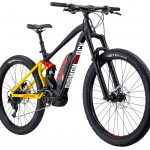Hi All. I was biking across the North York Moors a few days ago and may have damaged the controller by pushing the bike up hills and using the throttle to assist. Since I am going to have to get into it, could one of you suggest something a bit tougher, or even sine wave? The current size is 85x55x30mm, approx and i could maybe go a little larger. Any suggestions please? By the way, I had increased the current limit from 15A to about 20A, so it was my fault!
Controller Replacement
- Thread starter JohnD135
- Start date
The problem is that small controllers are not very good at dealing with heat, and the higher the current, the nore heat you get. It might be better to go up to 48v, which allows you to get higher torque at a lower current. 15A at 48v gives about the same torque as 20A at 36v. The heat generated is related to the square of the current, so 15A gives only 56% of the heatForgot to say, my current controller is an S-KU65.
Thanks for your reply. Unfortunately I am committed to 36V, having two batteries at that voltage. I suppose, what I can do is to connect the controller to the frame to reduce the temperature of the case. The current location of the controller is about as bad as it could be from a thermal point of view, being in a small closed box. I have read, on another thread, that a partial failure of these devices is possible. Is that your opinion? If it is, I will change it. Do they do small sine controllers?
What do you mean by partial failure?Thanks for your reply. Unfortunately I am committed to 36V, having two batteries at that voltage. I suppose, what I can do is to connect the controller to the frame to reduce the temperature of the case. The current location of the controller is about as bad as it could be from a thermal point of view, being in a small closed box. I have read, on another thread, that a partial failure of these devices is possible. Is that your opinion? If it is, I will change it. Do they do small sine controllers?
KT 15A controller is smaller than yours. They do 17A, 20A and 22A ones that are around the size of yours, though you have to hunt them out on Aliexpress and the Chinese resellers. My 22A one is quite small, but that means it can't lose heat so easily and I have to think about what power I'm using to avoid it over-heating, though it has never over-heated yet.
Another thing that affects heat a lot is speed. The slower you go the more heat you make, so If you've got a long hill, you really need to keep the speed as high as you can. In that respect, running with higher power to go faster can make everything run a lot cooler.
You say your 22A is small and so can't lose heat. I suppose you are thinking that there is little room for air circulation and small surface area, etc. I take your point about higher speeds. If you have a limit on power, and power equals torque times revs and torque is proportional to current. Are there any advantages to sine controllers please?
Sinewave controllers make the motor run smoother and quieter than with squarewave ones.You say your 22A is small and so can't lose heat. I suppose you are thinking that there is little room for air circulation and small surface area, etc. I take your point about higher speeds. If you have a limit on power, and power equals torque times revs and torque is proportional to current. Are there any advantages to sine controllers please?
Remember, there's input power from the battery and output power from the motor. The difference accelerates upwards as the speed goes down. The difference becomes heat in the motor. More heat is also made in the controller when the current is high.
The current is dependent on two things: the regulation from the controller that measures it and uses PWM to control it; and it's affected by the back emf, which reduces the applied voltage as the speed goes up, where Ohm's law gives Current = net Voltage/resistance
I understand about I squared R losses. Also the slope of the current increase with time in the inductance of the motor winding being effected by the motor back emf.
Thanks for the tip about overheating at low speed. I will provide a heat path from the controller to the chassis.
It doesn't sound as though there is much advantage in going sine, performance wise.
As to "partial failure". On reflection, most fet power systems either fail or don't. So I should stop worrying!
Thanks for your help.
Thanks for the tip about overheating at low speed. I will provide a heat path from the controller to the chassis.
It doesn't sound as though there is much advantage in going sine, performance wise.
As to "partial failure". On reflection, most fet power systems either fail or don't. So I should stop worrying!
Thanks for your help.
Related Articles
-
 Bosch eBike announce new motors, batteries & anti-tuning software
Bosch eBike announce new motors, batteries & anti-tuning software- Started by: Pedelecs
-
 Member reviews: 2017 KTM Fogo 271
Member reviews: 2017 KTM Fogo 271- Started by: EddiePJ
-
 2018 Giant – E+1 SX Pro Review
2018 Giant – E+1 SX Pro Review- Started by: EddiePJ
-
 DiamondBack Ranger debuts in UK
DiamondBack Ranger debuts in UK- Started by:


